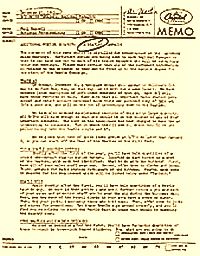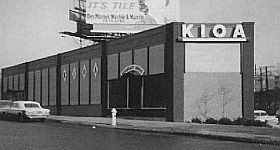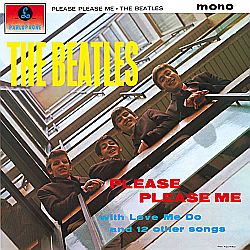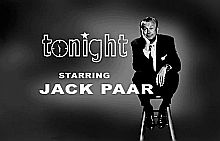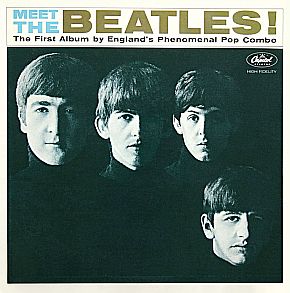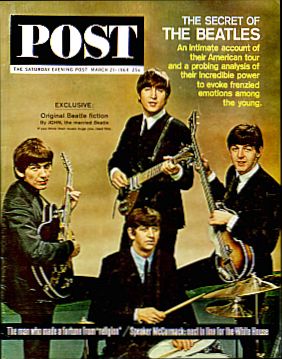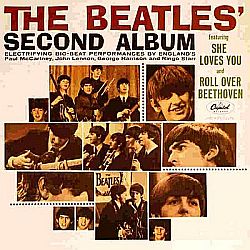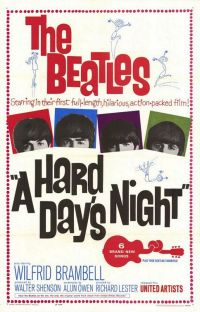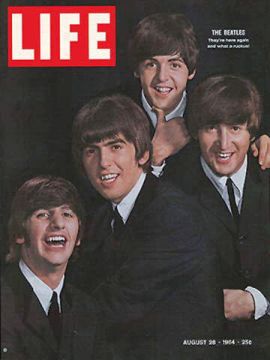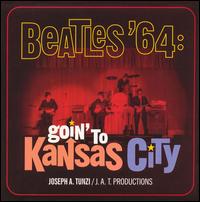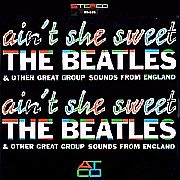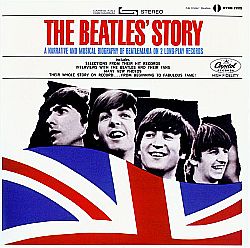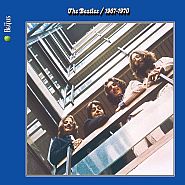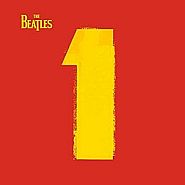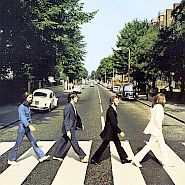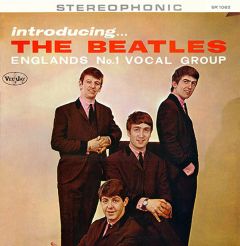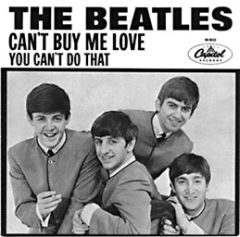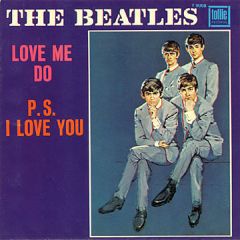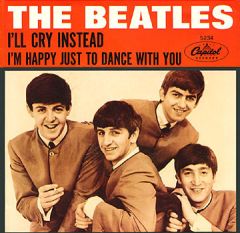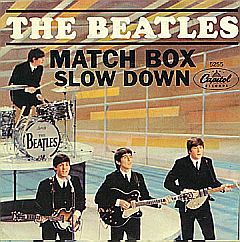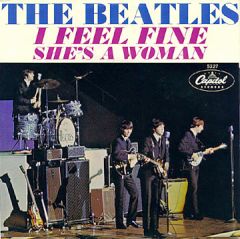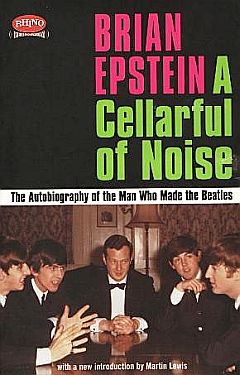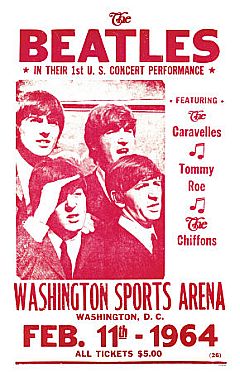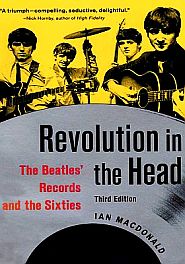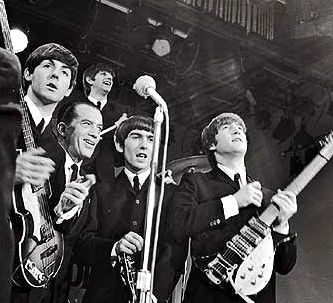
The Beatles in a session with Ed Sullivan prior to their February 9th, 1964 show. From left: Paul McCartney, Ed Sullivan, George Harrison, John Lennon, and behind & above, Ringo Starr.
Known by earlier names such as The Quarrymen, Johnny & The Moondogs, and The Silver Beatles, they played a variety of venues, with a change or two in personnel during those early years.
In Hamburg, Germany, and Liverpool, England, from about 1960 on, they worked hard and steadily in nightclubs, putting in long hours, improving their stage act, increasing their range of music, and writing their own songs. They were a cover band as well, as most English rock bands then were. They offered their own versions of Buddy Holly, Little Richard, Chuck Berry, Carl Perkins, Larry Williams, and others.
By late 1961, they were playing to packed houses at the Cavern nightclub in Liverpool, England where they were discovered by their manager-to-be Brian Epstein in November 1961. Epstein did a wardrobe and style make-over on them, cleaning them up for the music industry. By May 1962, after being rejected by a number of U.K. record labels, they signed a deal with EMI, then the U.K.’s leading music company.
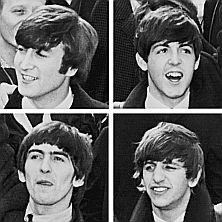
The Beatles as photographed upon arrival at JFK Airport in New York, Feb 7, 1964, from top left: John, Paul, George & Ringo.
Music Player
“Please Please Me”- 1963-64
The Beatles’ first U.K. album was titled Please Please Me, released in April of 1963. Within four weeks it would be the No.1 U.K. album, remaining in that position for 30 weeks, followed by their second U.K. album, With the Beatles. From then on, there came a string of No. 1 Beatles’ hits and No. 1 albums until the group broke up in 1969-1970.
In the American music industry, however, there was an initial hesitancy about the Beatles, as some record executives and DJs, especially in 1963, didn’t think that British acts generally would do well in America. That perspective would soon change.
What follows below is a timeline marking the rise of Beatles’ music and appearances in the U.S. during 1963 and 1964, along with a few photos, anecdotes, and sidebar stories. It is not a complete and comprehensive treatment of the Beatles’ activities during these years, nor is it meant to be. There are entire books and websites devoted to that topic, some of which are noted in “Sources & Additional Information” at the end of this article. What is offered here, hopefully, is a representative sampling of activity in those first two “Beatles-in-America” years, mixing in music history, business developments, and news-of-the-times — plus one or two stories that may be new to many readers.
_______________________________________________________
“Beatles-in-America Timeline”
1963-1964
January 1963
George Martin of EMI in London sends a copy of “Please Please Me” to U.S. subsidiary Capitol Records, urging executives there to distribute Beatles’ songs in the U.S. They decline, saying: “We don’t think the Beatles will do anything in this market.” Lesser known labels then begin picking up Beatles’1963 songs for U.S. release.

Vee-Jay single of Beatles’ “Please Please Me,” in Feb 1963, distinguished by ‘Beattles’ mis-spelling, later corrected. Click for digital.
25 Jan 1963
Vee-Jay record label of Chicago obtains a contract to release limited number of Beatles records in the U.S. for a limited time period.
25 Feb 1963
“Please Please Me”/ “Ask Me Why” released as single on Vee-Jay label. The song is played on Chicago’s WLS radio station by DJ Dick Biondi (making him the first American DJ to play Beatles music). The song reaches No. 35 on the WLS music survey in March. However, the song does not chart nationally; not on Billboard.
27 May 1963
“From Me To You” / “Thank You Girl” released as a single by Vee-Jay, but is barely visible; No. 116 on August Billboard chart, drops off thereafter.
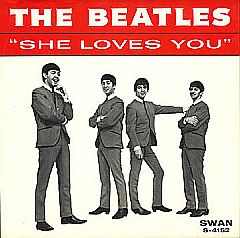
Record sleeve for ‘She Loves You’ / 'I’ll Get You’ single issued by Swan Records in Sept. 1963, which went ‘virtually unnoticed.’ Click for digital.
16 Sept 1963
“She Loves You” / “I’ll Get You” released in U.S. by Swan Records, a Philadelphia label, but does not chart on Billboard.
31 Oct 1963
American TV variety show host, Ed Sullivan, traveling to London, has his arrival delayed at London Heathrow Airport by a screaming crowd of teens welcoming the Beatles home from a tour of Sweden. Sullivan has his first thoughts of booking these rising British music stars with strange haircuts — perhaps as novelty act.
11-12 Nov 1963
Beatles manager Brian Epstein travels to New York and persuades Ed Sullivan to book the Beatles for an unprecedented three consecutive appearances on Sullivan’s much-watched Sunday evening variety show — February 9th, 16th and 23rd, 1964. CBS-TV gets one year’s exclusive rights to the Beatles’ U.S. television appearances.
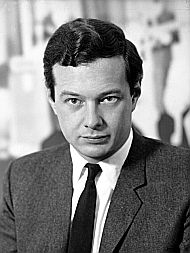
Brian Epstein, who discovered the Beatles and became their manager, also negotiated early business deals and arranged for publicity.
Time magazine take notice of the “Beatlemania” craze sweeping England and the Beatles’ command performance for British royalty in London.
16 Nov1963
CBS News bureau London — at the suggestion of Beatles’ manager Brian Epstein — sends a news crew to the British seaside resort of Bournemouth where they film a Beatles concert, thousands of screaming fans, and a few Beatles’ comments on camera. This film clip is later sent to New York.
Mid-late Nov 1963
Brian Epstein phones Capitol Records president Alan Livingston over label’s refusal to distribute Beatles songs in America. Epstein urges Livingston to listen to the U.K. single, “I Want To Hold Your Hand,” while mentioning the Beatles’ upcoming 1964 Ed Sullivan Show appearances as a big opportunity for Capitol. Livingston later agrees to spend $40,000 for Beatles promotion, equal to about $250,000 in today’s money.
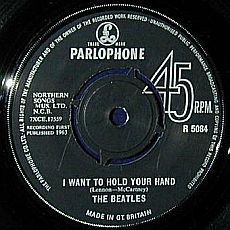
Beatles’ ‘I Want To Hold Your Hand' song that Brian Epstein asks Capitol Records Alan Livingston to consider, Nov 1963. Click for digital.
18 Nov 1963
NBC’s evening news program, The Huntley-Brinkley Report, airs a four-minute segment on the Beatles.
22 Nov 1963
U.K. album, With The Beatles, is released in the U.K., rising to No. 1 on the British album charts and remaining there for 21 weeks. With The Beatles becomes the Beatles’ first million-selling album in Britain, and the second album of any kind in Britain to sell one million copies, the first being the South Pacific soundtrack.
22 Nov 1963
The “CBS Morning News With Mike Wallace” runs a story on the Beatles for the network’s morning news show. CBS planned to repeat the segment that evening on Walter Cronkite’s newscast. However, that day, in mid afternoon, Walter Cronkite was breaking the tragic news to a shocked nation that their President, John F. Kennedy, had been shot and killed while visiting Dallas, Texas.
29 Nov 1963
The Beatles’ single “I Want To Hold Your Hand” is released in the U.K. and immediately hits No. 1 on the British pop charts.
|
“Dick Clark & The Beatles” The Beatles in England by this time were already a sensation, with hit after hit, setting music sales records. On August 23, 1963, the Beatles released the song “She Loves You” in the U.K. on EMI’s Parlophone record label. “She Loves You” hit No. 1 in the U.K. on August 29, 1963. However, in the U.S., Capitol Records, a subsidiary of EMI, declined to issue “She Loves You” in America. They had also not issued other Beatles’ U.K hits — “Love Me Do”, “Please Please Me” and “From Me To You.” That left the door open to other smaller companies to obtain the U.S. distribution rights for Beatles’ songs. 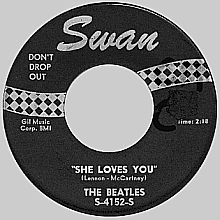 Swan Records released the Beatles’ ‘She Loves You’ in Sept 1963, but it went nowhere. Re-issued in early 1964 after Beatles’ music soared, it hit No. 1 in March. Click for vinyl. According to John Jackson’s excellent book, American Bandstand: Dick Clark and the Making of a Rock ‘n Roll Empire, Bernie Binnick acquired the American rights for “She Loves You” for his Swan Record label while on vacation in England in the summer of 1963. When he returned, he pressed his old friend Dick Clark about the song, obviously hoping for some American Bandstand attention. “What do you think?” he reportedly asked Clark, who replied that the song sounded like “Buddy Holly and the Crickets and Chuck Berry and a lot of other early American songs sort of mixed together.” Clark was not reassuring, though Binnick tried to interest Clark in the new group’s novel look. But after glancing at a picture of the Beatles, Clark noticed their long hair and reportedly told Binnick, “you’re absolutely insane….It’ll never fly.” Still, Binnick’s Swan label released “She Loves You” to the American market in mid-September 1963. But nothing happened. Clark, meanwhile, appears to have given the record a review on American Bandstand’s “rate-a-record” segment — probably in the Oct-Nov period. Bandstand’s “rate-a-record” consisted of a selected group of teenagers reviewing several new records that were played, then rated on a numeric scale by the teens who were interviewed by Clark. “She Loves You” reportedly did poorly on the rate-a-record segment, earning a seventy-one out of a possible ninety-eight points — not an impressive showing. According to another account, Clark would later explain that the Beatles’ disc rated “just fair.” He also added, “then I pulled a picture of the group out, and the audience just giggled. I figured these guys were going nowhere.” But as Clark would later acknowledge, “We all found out the truth soon enough.”  New songs were rated by teens on Bandstand, who reportedly gave the Beatles’ ‘She Loves You’ a poor rating in 1963. Binnick, meanwhile, had a pile of newly pressed Swan recordings of “She Loves You” going nowhere. Then in late 1963 he got a telephone call from Beatles’ manager, Brian Epstein, who was then in New York arranging an American television appearance for the Beatles. Epstein wanted to know how “She Loves You” was doing in America. Binnick replied that the record was “a stiff.” Epstein shot back that it might soon become a huge hit, explaining that the Beatles were going to appear on The Ed Sullivan Show. Binnick, unimpressed, told Epstein he “blew it,” saying he should have had the Beatles appear on Dick Clark’s American Bandstand rather than The Ed Sullivan Show, suggesting that Clark’s show was more popular. About a month or so later, Jack Paar, who hosted a Friday evening variety TV show on NBC, had just returned from England that December, marveled to his viewing audience over the “Beatlemania” that he had observed overseas. Paar was also able to get a film clip of the Beatles performing “She Loves You” in an English town, and he aired it on his show Friday, January 3, 1964, showing the Beatles performing the song as their teenage fans went wild. According to Binnick, “the record exploded [in sales] the following Monday.” Binnick and Swan re-issued “She Loves You” to meet demand. By March 21st it would become the No. 1 hit in the land. “She Loves You,” in fact, would sell 1 million copies, creating a temporary windfall for Binnick and Swan Records. However, Swan’s option on future Beatles songs had been lost since it stipulated that ‘She Loves You” had to sell 50,000 copies in its first year, 1963, which it did not. Swan also had the rights to the German version of “She Loves You,” which did reasonably well too, but not enough to save Swan from its troubles. The company went out of business in 1967. As for Dick Clark’s American Bandstand, the Beatles never did appear on the show; they didn’t need to. |
29 Nov 1963
Radio station KIOA in Des Moines, Iowa begins playing “I Saw Her Standing There” from a Drake University student’s copy of Beatle’s U.K. album, Please Please Me, and a few days later, “I Want to Hold Your Hand,” from a U.K. Beatles’ single (see sidebar story below).
1 Dec 1963
The New York Times Sunday Magazine, runs a story on “Beatlemania” in the U.K.
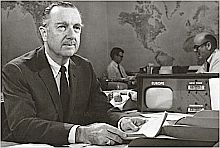
4 Dec 1963
Capitol Records issues a press release announcing that it will begin selling the Beatles’ first U.S. 45 rpm single, “I Want To Hold Your Hand,” on Monday, January 13th, 1964.
10 Dec 1963
A four-minute CBS film segment on The Beatles that had been pre-empted by the JFK tragedy is aired on Walter Cronkite’s CBS Evening News.
Radio disc jockey Carroll James at Washington. D.C. station WWDC, plays rare U.K. copy of “I Want to Hold Your Hand” on the radio after 15-year-old girl from Silver Spring, MD wrote to him requesting Beatles music after seeing the CBS-news segment. James arranged to have an airline stewardess buy a U.K. copy of the Beatles’ latest single in London. Listeners phone in repeatedly to request the song.
18-19 Dec 1963
Capitol Records threatens to sue WWDC to stop playing song, but then reverses itself and decides to rush-release “I Want To Hold Your Hand,” previously scheduled for January 13, 1964. Christmas leave is canceled at Capitol Records, as pressing plants and staff gear up for rush release.
23 Dec 1963
Capitol Records issues a memo to its sales people and regional managers across the country, outlining an extensive “Beatles Campaign” using various promotional items — from major music magazine trade ads and a fake tabloid Beatles newspaper (reprinted in the thousands), to Beatle buttons, Beatle stickers, Beatle wigs, and a battery-powered, “Beatles-in-motion,” bobble-head-like, window display for music stores.
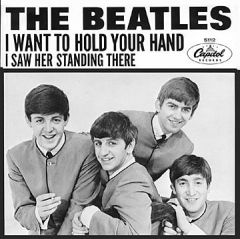
The Beatles’ single ‘I Want To Hold Your Hand,’ issued by Capitol Records, went on sale in the U.S. in late December 1963. Click for vinyl re-issue.
Capitol Records begins distributing “I Want To Hold Your Hand” to radio stations in major U.S. cities where it is played regularly. With teens home for Christmas-New Years break, radios get full-time use, and the record begins selling like crazy. In New York City, 10,000 copies are sold every hour. In the first three days, 250,000 copies are sold. Capitol was so overloaded it contracted Columbia Records and RCA to help with the pressings.
28 Dec 1963
The New Yorker magazine publishes a Brian Epstein interview; regarded as first serious article in U.S. about the Beatles and their manager.
29 Dec 1963
New York city radio station WMCA joins others broadcasting “I Want To Hold Your Hand.” Back in London, meanwhile, Sunday Times critic Richard Buckle praises the Beatles as the greatest composers since Beethoven.
A two-page ad from Capitol Records pitching the Beatles’ recordings runs in Billboard and Cash Box music industry magazines. Bulk reprints of these ads have already been distributed to Capitol’s sales agents for use with radio stations and in enlarged, easel-scale size for use in music store displays across the country.
3 Jan 1964
Jack Paar, host of the late night U.S. TV talk show, “The Jack Paar Show,” airs a filmed Beatles’ performance of “She Loves You” from England. It is the first complete Beatles song shown on American TV, and for many in America, the first time they see the Beatles.
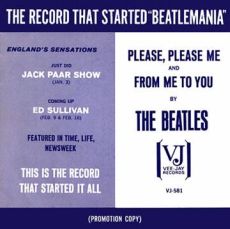
V-J’s promotional cover sleeve for Beatles’ ‘Please Please Me’ single following Jack Paar show, Jan 1964.
10 Jan 1964
Vee-Jay Records releases the first Beatles album in the U.S., Introducing…The Beatles. Legal and business issues plague the album, but by late fall, it would sell more than 1.3 million copies.
10 Jan 1964
Two weeks after the Capitol Records release of “I Want To Hold Your Hand,” sales hit 1 million copies — a staggering number at that time for an unknown music group from overseas.
mid-Jan 1964
Vee-Jay Records’ issues special record sleeves for promoting “Please Please Me” to radio DJs, noting Beatles’ clip on Jack Paar’s show, upcoming Ed Sullivan Show dates, and national news coverage in Time, Life & Newsweek magazines.
17 Jan 1964
“I Want to Hold Your Hand” by The Beatles is the No. 1 single in America.
20 Jan 1964
Capitol Records issues Meet the Beatles, the Beatles’ first Capitol album in the U.S.
20 Jan 1964
To promote the Meet The Beatles album and their upcoming first American visit, Capitol Records distributes pre-recorded interview with the Beatles to American radio stations.
29 Jan 1964
Capitol Records announced in a press releases, that Meet the Beatles had already sold 400,000 copies by January 27th.
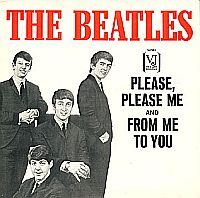
Vee-Jay's "Please Please Me," released a 2nd time, late Jan 1964.
30 Jan 1964
Vee-Jay Records releases, for the second time, the single “Please Please Me” / “From Me to You,” entering the Billboard chart at No. 69. It would later reach No. 3, and Vee-Jay would sell at least 1.1 million copies.
7 Feb 1964
At about 1:20 p.m. the Beatles arrive at Kennedy International Airport in New York where they are greeted by 3,000 screaming teenagers, 200 reporters and photographers, and more than 100 New York police officers. At a televised press conference the Beatles come off as witty, charming and playful.
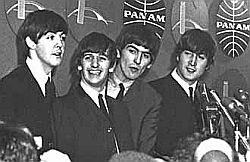
Beatles at press conference after landing in New York, February 7, 1964.
9 Feb 1964
Elvis Presley sends The Beatles a telegram wishing them well in their upcoming Ed Sullivan Show appearance later that evening.
9 Feb 1964
Beatles perform live on The Ed Sullivan Show, reaching a record-breaking audience of 73 million, or according to A.C. Nielsen, 23.2 million households. One estimate at 40% of population. They perform five songs: “All My Loving,” “Till There Was You,” “She Loves You,” “I Saw Her Standing There” and “I Want To Hold Your Hand.”
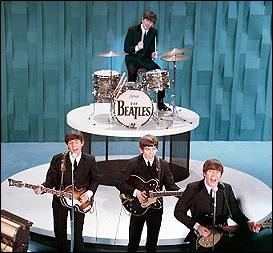
Beatles performing on ‘Ed Sullivan Show,’ Feb 9, 1964, before estimated TV audience of 73 million. Click for DVD.
11 Feb 1964
The Beatles give their first live concert performance in the U.S. at the Washington Coliseum in Washington, D.C.
12 Feb 1964
The Beatles perform two shows at Carnegie Hall in New York City.
16 Feb1964
Second appearance on The Ed Sullivan Show, live from the Deauville Hotel in Miami Beach, Florida. Approximately 70 million people tune in, or 22.4 million households. Songs performed: “She Loves You,” “All My Loving,” “This Boy,” “I Saw Her Standing There,” “From Me to You,” and “I Want to Hold Your Hand.”
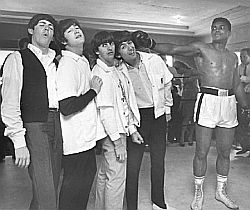
Beatles clowning with boxer Cassius Clay (later known as Muhammad Ali) during visit to Miami, FL, Feb 1964. Photo, Harry Benson.
22 Feb 1964
The Beatles return to London, U.K.; at Heathrow Airport at 7 a.m. they are met by an estimated 10,000 fans.
23 Feb 1964
Beatles appear for 3rd time on Ed Sullivan Show, a performance that was taped earlier in New York — performing three songs: “Twist and Shout”, “Please Please Me” and “I Want to Hold your Hand.”
13 Mar 1964
Meet the Beatles LP by this date is reported to have sold 3,600,000 copies. “Can’t Buy Me Love” their next single, has advance orders of 1,700,000 copies in the U.S.
14 Mar 1964
“Please Please Me” is a massive hit, rising to No. 3 on the Billboard Hot 100 chart by this date.
16 Mar 1964
“Can’t Buy Me Love/You Can’t Do That” is released as single by Capitol Records; sells 940,225 copies first day, 2.1 million by March 19th.
21 Mar 1964
Beatles appear on the cover of The Saturday Evening Post, one of America’s mainstream magazines at the time. Post’s cover story — “The Secrets of The Beatles” — promises “an intimate account of their American tour and a probing analysis of their incredible power to excite frenzied emotions among the young.”
23 Mar 1964
“Do You Want to Know a Secret” / “Thank You Girl” released as a Vee-Jay single.
28 Mar 1964
Capitol Records reports sales of “I Want To Hold Your Hand” in excess of 3.4 million copies.
31 Mar 1964
The Beatles hold the top five slots on Billboard: (1) Can’t Buy Me Love, (2) Twist and Shout, (3) She Loves You, (4) I Want To Hold Your Hand (5) Please Please Me — a musical first.
10 Apr 1964
The Beatles’ Second Album is released by Capitol Records, which replaces the Beatles first Capitol album, Meet The Beatles, at No. 1 on the Billboard album chart from May 5th to June 2nd.
11 Apr 1964
The Beatles hold 14 slots on Billboard’s Hot 100 chart.
14 Apr 1964
The Beatles’ Second Album reaches $1 million in sales by this date.
|
Beatles’ Hot 14 1. Can’t Buy Me Love |
27 April 1964
“Love Me Do”/ “P.S I Love You” released as single by Tollie Records, a Vee-Jay subsidiary.
1 June 1964
“Sweet Georgia Brown” / “Take Some Insurance Out on Me” released as Atco Records single.

‘A Hard Day’s Night’ became one of the fastest-selling soundtrack albums of the 1960s. Click for CD.
June 1964
Advance orders for the soundtrack album from the Beatles’ forthcoming film, A Hard Day’s Night, are 250,000 in the U.K. and 1 million in the U.S.; album would sell 2 million copies in the U.S. by October, and 600,000 in the U.K. by year’s end. American version, with somewhat different songs, was released on June 26, 1964 by United Artists Records.
June 1964
The Beatles fly to Hong Kong, June 8-10, perform two concerts there and then go to Austrailia, June 12-14. In Adelaide, Australia they are greeted by an estimated crowd of 300,000 along their motorcade route.
13 July 1964
“A Hard Day’s Night” / “I Should Have Known Better” released as single by Capitol Records.
20 July 1964
“I’ll Cry Instead”/ “I’m Happy Just To Dance With You” released as single by Capitol Records.
20 July 1964
“And I Love Her”/ “If I Fell” released as single by Capitol Records, as well as a new Beatles’ album, Something New.
11 Aug 1964
Beatles first film, A Hard Day’s Night, opens in America and is a huge hit. Shown in 500 theaters across U.S., it earns $1.3 million in the first week. Some 15,000 prints made for world-wide distribution — historical first in film industry.
12 Aug 1964
Variety magazine reports that by August 1964, the Beatles had sold approximately 80 million records globally.
19 Aug 1964
The Beatles perform at the Cow Palace in San Francisco, California, in the first concert of their USA/Canada tour, which lasts a month through August and September.
24 Aug 1964
“Matchbox” / “Slow Down” is released as a single by Capitol Records.
August 1964
The Beatles received a request from the White House press office to be photographed with President Lyndon B. Johnson, laying a wreath on the grave of John F. Kennedy. The request was politely declined by their manager, Brian Epstein, saying it was not the group’s policy to accept “official” invitations.
25 Aug 1964
The Beatles’ single, “A Hard Day’s Night,” is certified gold for exceeding sales of more than 1 million copies.
26 Aug 1964
Beatles’ North American tour plays Denver, Colorado.
27 Aug 1964
Beatles’ North American tour plays Cincinnati, Ohio.
28 Aug 1964
Life magazine article reports that the Beatles’ 33-day tour of 23 American cities is a sell out at every location and is expected to gross millions. Beatles pandemonium at the time is such that some hotels along the tour route refused to house the Beatles, and Los Angeles’ Lockheed Airport forbad any Beatles plane from landing there for fear of screaming fans running on to the tarmac.
|
“Charlie O & The Beatles” 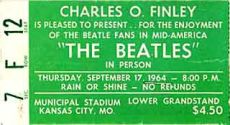 Ticket stub, Beatles' Sept 17,1964 concert in Kansas City, MO. 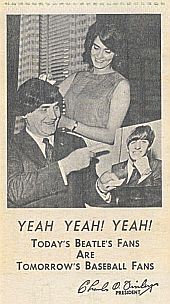 Finely on ticket back. At the concert, however, a crowd of 20,207 attended, which was just over half of Municipal Stadium’s full capacity of 35,000 when seats were installed on the field. The drop off in attendance was due in part to local animosity over Finely’s record with the Athletics and some of his promotional antics, which weren’t always welcomed in the community. In fact, the local media at the time, and especially The Kansas City Star, suggested boycotting the Beatles’s concert as a way to protest Finley’s unpopular management of the Athletics. Still, thousands came out, as Beatles’ fans heard a full set of their tunes performed that night. Finley, meanwhile, who had earmarked profits from the event for Children’s Mercy Hospital, had to write a $25,000 check to cover the minimum donation he had pledged to the hospital in the event that the concert did not earn a profit. |
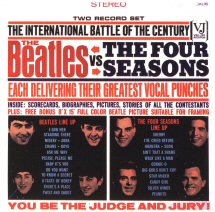
Vee-Jay Record’s “Beatles vs. Four Seasons” two-album set, October 1964.
The Ed Sullivan Show replays broadcast of Beatles’ February 16th appearance on the show.
1 Oct 1964
The Beatles vs. The Four Seasons two-record set is released by Vee-Jay Records. Package is basically two previous albums — 1963’s Golden Hits of the 4 Seasons and VJ’s Beatles album, Introducing The Beatles. VJ hypes the package as “The International Battle of the Century!”
1 Oct 1964
Book by Brian Epstein, A Cellarful of Noise, is released by Souvenir Press; includes his autobiography and inside account of early Beatles. Later edition issued in 1998 by Byron Preiss Multimedia Books.
|
Beatles’ Tour Aug 19 San Francisco |
2 Oct 1964
As of this date, ten million Beatles’ records had been sold in the U.S.; their American concert tour had grossed at least $1 million; their film, A Hard Day’s Night, had reaped $5.8 million at the U.S. box office in six weeks. EMI, their record label, was reporting fiscal year sales of $265 million, up 12 percent largely on Beatles’ business. Capitol Records was reporting its revenues were up as well, by 17 percent. Brian Epstein and the Fab Four, meanwhile, were millionaires many times over, with total income earned beyond the U.K. then estimated to be some $56 million.
5 Oct 1964
Ain’t She Sweet album is released by Atco Records, an American album featuring four 1961 Beatles tracks from Hamburg, Germany and cover versions by other British groups.
13 Nov 1964
CBS TV shows a 50-minute doc- umentary, “What’s Happening! The Beatles in the U.S.A.,” filmed by Albert Maysles, covering the Beatles U.S. tour and other activities that year.
23 Nov 1964
“I Feel Fine” / “She’s a Woman” single released by Capitol Records.
23 Nov 1964
The Beatles Story double LP is released by Capitol Records, billed as “a narrative and musical biography of Beatlemania on two long-play records.” The albums feature interviews, press conferences, and songs by the The Beatles. It was The Beatles’ fourth release by Capitol Records.
1 Dec 1964
Ringo Starr has his tonsils removed at the University College Hospital in London.
15 Dec 1964
Beatles ’65 album is released by Capitol Records featuring 11 Beatles’ cuts, among them: “I’m a Loser,” “Baby’s in Black,” “I’ll Follow the Sun,” “Mr. Moonlight,” “Honey Don’t,” “I’ll Be Back,” “She’s a Woman,” and “I Feel Fine.”
December 1964
Christmas recordings, with Christmas songs and messages from individual Beatles, are sent to fan club members in the U.K and U.S.
1964 Grammys
The 7th Grammy Awards, held in 1965, recognized the accomplishments of musicians for the year 1964. This was the year musically when Barbra Streisand won a Best Vocal Performance award for “People,” and Louis Armstrong for “Hello, Dolly!”; the year Stan Getz and Astrud Gilberto won Record of the Year for “The Girl from Ipanema,” and songwriter Jerry Herman, Song of the Year, for “Hello, Dolly!” 1964 was also the year that Henri Mancini won a Grammy for the “Pink Panther Theme” and Roger Miller took home several Country & Western music awards, while Nancy Wilson won Best Rhythm & Blues Recording, Petula Clark for “Downtown,” and Gale Garnett, Best Folk Recording for, “We’ll Sing in the Sunshine.” Not to be left out, of course, The Beatles won two awards: Best New Artist and Best Performance by a Vocal Group for “A Hard Day’s Night.” But the Beatles’ 1964 arrival left its mark on more than music awards.
A Sound of Change
The Beatles’ bursting onto the music scene of 1963-64 with their numerous popular songs has been described by some historians as a rare “pop explosion” — a musical infusion lasting basically four years, 1963-1967. This Beatles’ infusion, however, produced change that would last much longer than four years, not only in music but more broadly throughout popular culture — in fashion, literature, politics and beyond. But it would all start with the music, especially that first flush of Beatles’ songs in 1963-64. What the Beatles had then, according to rock music historian Greil Marcus writing for The Rolling Stone Illustrated History of Rock & Roll, “was that elusive rock treasure, a new sound — and a new sound that could not be exhausted in the course of one brief flurry on the charts.”
|
Bob Dylan “We were driving through Colorado [and] we had the radio on and eight of the Top Ten songs were Beatles songs. In Colorado! ‘I Want to Hold Your Hand,’ and those early ones. “They were doing things nobody was doing. Their chords were outrageous, just outrageous, and their harmonies, made it all valid… But I kept it to myself that I really dug them. Everybody else thought they were for the teenyboppers, that they were gonna pass right away. But it was obvious to me that they had staying power. I knew they were pointing the direction that music had to go…in my head, the Beatles were it. In Colorado, I started thinking but it was too far-out. I wouldn’t deal with it — eight in the Top Ten. “It seemed to me a definite line was being drawn. This was something that never happened before.” |
This new Beatles’ sound, according to Marcus, is best captured in a selection of their 1963-64 tunes, such as: “Please Please Me,” “I Saw Her Standing There,” “Boys,” “There’s A Place,” “It Won’t Be Long,” “All My Loving,” “She Loves You,” “A Hard Day’s Night,” “Things We Said Today,” “Eight Days A Week,” among others. This Beatles’ sound, at that time, was different and unique — exciting, optimistic, playful, and fresh. Also unique was what the Beatles did together musically — i.e., their group dynamic; beat, rhythm, vocals, composition, etc. — yielding a very high level of music quality. It blew away most of the competition. In fact, what the Beatles had in this case was “so fluid and intelligent,” says Greil Marcus, “that for years they made nearly everything else on the radio sound faintly stupid.”
Between January and March 1964, the Beatles accounted for 60 percent of all record sales in the U.S. In 1964 alone, the Beatles put 19 hit songs in the Top 40, and 30 in the Top 100. They had 15 separate recordings in 1964 — nine singles and six albums — that each sold 1 million or more copies, representing total Beatle sales in the U.S. that one year of more than 25 million copies. That feat has never been matched. Many of the Beatles’ songs from 1964 went on to enjoy continued success. “I Want To Hold Your Hand” would proceed to have worldwide sales of 15 million copies, the largest-selling single in rock history until Elton John’s 1997 version of “Candle in the Wind” for Princess Diana, eclipsed it. “Can’t Buy Me Love” would have worldwide sales of 6 million; “She Loves You,” 5 million, and several others from that year each surpassing 2 million or more copies.
On Billboard, the prominent U.S. music chart that reflects single and album popularity and success, the Beatles set a slew of records, most in the March-April 1964 period, but a few of which still stand today. Among their marks in 1964: most songs on the Billboard Hot 100 chart at the same time (14); most songs within the Billboard Top 40 ranking at the same time (7, on two occasions); most songs within the Billboard Top 10 and Billboard Top 5 at the same time (5); and most songs charting on the Billboard Hot 100 within a calendar year (30). On April 4, 1964, Beatles’ singles and albums simultaneously held the top five Billboard singles spots and the top two Billboard album ratings — a record that still stands.
The Beatles’ impact, of course, goes well beyond their music-chart numbers in 1963-64. Yet these Beatle years marked a turning point for rock ‘n roll, both musically and as a business. From their Ed Sullivan Show appearance onward, the Beatles made plain the power of good music meeting the right demographic — in this case, Baby Boomer disposable income.…Between January and March 1964, the Beatles accounted for 60 percent of all record sales in the U.S. In 1964 alone, the Beatles put 19 hit songs in the Top 40, and 30 in the Top 100. This Boomer market was clearly visible before the Beatles’ pop explosion, but they certainly took it to another level, revealing a gigantic “rock business” segment that would only expand over the next several decades in all manner of ways, from concert touring to MTV and beyond. In 1964, the Beatles opened the door for other British rockers that helped to change and enlarge the nature of the rock music business globally. In that year, for example, the Dave Clark Five, Dusty Springfield, the Searchers, Billy J. Kramer, Peter & Gordon, Gerry & the Pacemakers, the Animals, Manfred Mann, the Zombies, Herman’s Hermits, and the Rolling Stones all had Top 20 hits on the U.S. music charts. It wasn’t just the British sound, of course, as all of rock ‘n roll was going great guns by then — from Motown to the Surf sound, the Beach Boys to the Supremes, Bob Dylan to Marvin Gaye, and many more to come. But the Beatles had their distinct effects on the music business — influencing the rise of album format in rock music, for example, and also presaging and influencing the music video era with their 1960s’ film-making techniques. The Beatles were also one of the first acts to package and exploit pop music as a multi-media business opportunity — combining music, television, film, concerts, and merchandising.
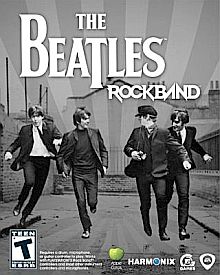
Beatles’ "Rock Band" video game, released internationally Sept 2009, features more than 40 Beatles songs. Click for video game.
Today, more than 40 years after the Beatles’ musical explosion of 1963-64, their music from that era is still a cultural and business phenomenon. By September 2009, Beatles’ songs from the 1960s were being used again to form a major new Beatles’ business built around family-based video games. And in November 2010, Beatles’ songs were made available on iTunes and similar digital media.
In any case, the sales of Beatles’ music — whether for video games or digital media — will only add to the 1.6 billion singles and albums already credited to their legacy.
See also at this website other Beatles stories, including: “Beatles’ D.C. Gig: 1964,” featuring their first live performance in America; “Dear Prudence: 1967-68,” which includes the famous Beatles song of that name and detail on their trip to India at that time;’ and “Tomorrow Never Knows,” a profile of the group in 1966 and an early psychedelic-era Beatles song that also made a cameo in a 2015 MadMen TV episode.
A Beatles “topics page” can also be found at “Beatles History.” For additional stories that profile other popular music, artists, and various uses of music in politics, advertising and film, see the “Annals of Music” page.
Thanks for visiting – and if you like what you find here, please make a donation to help support the research and writing at this website. Thank you. – Jack Doyle
|
Please Support Thank You |
____________________________
Date Posted: 20 September 2009
Last Update: 27 January 2024
Comments to: jackdoyle47@gmail.com
Article Citation:
Jack Doyle, “Beatles in America, 1963-1964,”
PopHistoryDig.com, September 20, 2009.
______________________________
Beatles Music at Amazon.com…
Sources, Links & Additional Information
[Note: Click on images in right-hand column for related Amazon.com pages]
“The Beatles,” in Holly George-Warren and Patricia Romanowski (eds), The Rolling Stone Encyclopedia of Rock & Roll, Rolling Stone Press, New York, 3rd Edition, 2001, pp. 56-59.
“Singers: The New Madness,” Time, Friday, November 15, 1963.
Stephen Watts, “Nonconformists and Newcomers on the British Screen; Anomaly Universal “Beatles” Rising Star,” New York Times, Sunday, November 24, 1963, Arts & Leisure, p. 35.
Frederick Lewis, London, “Britons Succumb To ‘Beatlemania’,” New York Times Magazine, Sunday, December 1, 1963.
Lawrence Malkin, “Liverpudlian Frenzy; British Beatles Sing Up a Teen-Age Storm,” Los Angeles Times, December 29, 1963, p. G-4.
Ann Rauscher, “The Beatles in America: We Loved Them, Yeah, Yeah, Yeah,” Newseum, Washington D.C., February 5, 2009.
Paul Russell, National Album Merchandising Manager, Capitol Records, Memo to B/D Sales Managers, Regional Managers, “Additional Meeting Subject: The Beatles! Campaign,” December 23, 1963, 2 pp.
Jack Gould, “TV: It’s the Beatles (Yeah, Yeah, Yeah); Paar Presents British Singers on Film,” New York Times, Saturday, January 4, 1964, Business, p 47.
Bob Scott, “Beatles Bounce Over,” Los Angeles Times, January 26, 1964, p. A-24.
Capitol Records, Inc., Press Release, “What’s Happening in Beatleland …,” January 29, 1964.
CBS, Inc., Press Release, “The Beatles to Make Three Appearances on Sullivan Show,” February 3, 1964.
CBS, Inc., Press Release, “Beatles Will Sing Their Number One Hit on the Ed Sullivan Show,” February 5, 1964.
Paul Gardner, “3,000 Fans Greet British Beatles; 4 Rock ‘n’ Roll Performers Hailed by Teen-Agers,” New York Times, Saturday, February 8, 1964, Food & Fashion, p. 25.
“‘Beatles’ Descend on New York; Teen-Agers Frantic,” Washington Post-Times Herald, February 8, 1964; p. A-4.
“Girls Go Bug-Eyed as Beatles Perform,” Los Angeles Times, February 10, 1964, p. 2.
L. Laurent, “Beatles Set Back Cultural Exchange,” Washington Post-Times Herald, February 12, 1964, p. C-7.
Jerry Doolittle, “Beatles Arrive, Teen-Agers Shriek, Police Do Their Duty, and That’s That,” The Washington Post-Times Herald, February 12, 1964, p. 1.
“Teen-Agers in Capital Squeal for Beatles,” Los Angeles Times, February 12, 1964, p. 14.
John S. Wilson, “2,900-Voice Chorus Joins the Beatles; Audience Shrieks and Bays and Ululates,” New York Times, February 13, 1964.
Bill Henry, “Yeah, Yeah for Those Beatles,” Los Angeles Times, February 14, 1964, p. A-1.
United Press International, “4,000 Hail Beatles on Arrival in Miami,” New York Times, Friday, February 14, 1964, p. 16.
John A. Osmundsen, “Peoplewise, the Beatles Provide New Study for the Sociologists,” New York Times, Monday, February 17, 1964, p. 1.
“Reds Claim Beatles Blind Youth to Woe,” Los Angeles Times, February 18, 1964, p. 17.
“Beatles Depart for Britain As 4,000 Admirers Scream,” New York Times, Saturday, February 22, 1964, Food & Fashion, p. 18.
Ronald J. Ostrow, “Beatles to Launch Theater Tele- vision,” Los Angeles Times, February 19, 1964, p. B-8.
“Singers: The Unbarbershopped Quartet,” Time, Friday, February 21, 1964.
“The Beatles in the United States,” Wikipedia.org, viewed September 2009.
“Please Please Me” (song), Wikipedia.org, viewed, September 2009.
John Whelan, “The Beatles Timeline,” Ottawa Beatles Site, January 1, 2000.
Saki & Ed Chenn, “American Bandstand and the Fabs,” Newsgroups: RecMusicBeatles, no date.
D. Lowe, Thomas Whiteside, The Talk of the Town, “Beatle Man,” The New Yorker, December 28, 1963, p. 23.
“Politician Cites Beatles,” Washington Post-Times Herald, March 9, 1964, p. A-9.
“Beatles Are Praised By Duke Ellington,” Washington Post-Times Herald, March 10, 1964, p. A-3.
“2 Million Will View Beatles at 170 Theaters,” Los Angeles Times, March 13, 1964, p. C-17.
“Song Writer Medal Presented Beatles,” Washington Post-Times Herald, March 23, 1964. p. B-23.
“Beatles Honored for Contribution to British Music,” Los Angeles Times, March 23, 1964, p. 23.
“Beatles Are Toppled From Hit Parade Peak,” Washington Post-Times Herald, April 15, 1964, p. A-2.
Gene Sherman, “The Man Behind the Beatles,” Los Angeles Times, May 3, 1964, p. B-1.
“250,000 Hail Beatles in Australia,”Los Angeles Times, June 15, 1964, p. 4.
“Beatles to Sing Six New Tunes in Their Movie,” Los Angeles Times, August 11, 1964, p. C-9.
“Yeah? Yeah. Yeah!: Yeah? Yeah. Yeah!,” Time, Friday, August 14, 1964.
“The Beatles Started It All,” Washington Post-Times Herald, August 14, 1964, p. C-5.
Hedda Hopper, “‘Hard Day’s Night’ Beatles’ Bonanza,” Los Angeles Times, August 15, 1964, p. B-6.
Penelope Gilliatt, “The Beatles in Their Own Right,” Washington Post-Times Herald, August 16, 1964, p. G-1.
Daryl Lembke, “Hysterical Fans Greet Beatles Here and in S.F.,” Los Angeles Times, August 19, 1964, p. A-1.
Louella Parsons, “Vegas Took the Beatles in Stride,” Washington Post-Times Herald, August 26, 1964, p. A-18.
“Britain: The Beatle Business,”Time, Friday, October 2, 1964.
Myra MacPherson, “Help! The Day The Mania Came To Washington,” Washington Post, February 7, 1984.
Dennis McLellan, “Alan W. Livingston Dies at 91; Former President of Capitol Records,” Los Angles Times, March 14, 2009.
Martin Lewis, “Tweet The Beatles! How Walter Cronkite Sent The Beatles Viral… in 1963!,” The Huffington Post, July 18, 2009.
Fred Bronson The Billboard Book of Number 1 Hits, Billboard Books, 5th edition, October 2003, 1,008 pp.
Bruce Spizer, Songs, Pictures and Stories of the Fabulous Beatles Records on Vee-Jay, Four Ninety-Eight Productions, April 1998, 242 pp.
Bruce Spizer, The Beatles Swan Song: She Loves You & Other Records, Four Ninety-Eight Productions, March 2007, 280 pp.
Bruce Spizer, The Beatles Are Coming! The Birth of Beatlemania in America, Four Ninety-Eight Productions, December 2003, 246 pp.
Stu Adams, “Defining Moments of The ’60’s at KIOA,” DesMoinesBroadcasting.com.
“List of The Beatles’ Record Sales,” Wikipedia.org, viewed September 2009.
“The Beatles Interviews Database” (with photos), Beatles Ultimate Experience, viewed, Sept 2009.
Beatles On The Charts, 1963 to1964, Dermon.com, According to Billboard Magazine.
“Beatles Record Sleeves,”RareBeatles.com.
Hank Bordowitz, Turning Points in Rock and Roll, New York: Citadel Press/Kensington Publishing, 2004, 282 pp.
Greil Marcus, “The Beatles,” in Anthony DeCurtis and James Henke, with Holly George-Warren (eds), The Rolling Stone Illustrated History of Rock n Roll, New York: Random House, revised edition, 1992, pp. 209-222.
Martin Goldsmith, The Beatles Come to America, J. Wiley & Sons, January 2004, 208 pp.
John C. Winn. Way Beyond Compare: The Beatles’ Recorded Legacy, Volume One — 1957-1965, Three Rivers Press, 416pp, 2008, and That Magic Feeling: the Beatles’ Recorded Legacy, Volume Two — 1966-1970, Three Rivers Press, 416pp, 2009.
Philip Norman, Shout!: The Beatles in Their Generation,” Simon and Schuster, 2005, revised edition, 546 pp.
Bob Spitz, The Beatles: The Biography, Little Brown, 2005.
Jonathan Gould, Can’t Buy Me Love: The Beatles, Britain and America, Piatkus Books, 2008.
“The First U.S. Visit: A Film by Albert and David Maysles,” DVD, Apple/Capitol Records, 1964, Revised 1990.
“The Beatles Anthology,” Directed by Geoff Wonfor, VHS, Apple/Capitol Records, DVD, Apple/Capitol Records, 1996.
“The Four Complete Historic Ed Sullivan Shows Featuring the Beatles,” VHS & DVD, Sofa Entertainment, 2003.
“The Beatles in Washington, D.C.,” Passport Video, 2003.
“Beatles Around the World,” DVD, Entertainment Properties, 2003.
Brian Epstein Website, BrianEpstein.com.
Beatles Books at Amazon.com…

